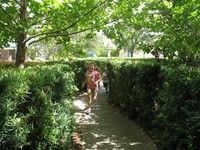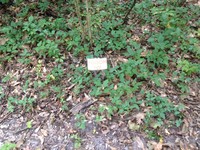


Summertime is here, and with it comes common summertime afflictions such as sunburns, bug bites and dehydration.
Learning to treat – and more importantly, prevent – these conditions was the focus of a recent Talk with a Doc at the Ponte Vedra YMCA’s Healthy Living Center. Dr. Francisco Martinez-Wittinghan of Baptist Primary Care in Nocatee served as guest speaker at the event, delivering the presentation “Prevent and Treat Summertime Bummers.”
“The most important thing for first aid is that we don’t have to use it,” Martinez-Wittinghan said.
Prevention is key, he said. For example, instead of treating sunburn or bug bites after the fact, try to prevent them in the first place by using sunscreen or bug spray. It’s also paramount to be aware of your surroundings and plan for outings: Whether your destination is the beach or the woods, plan to bring both preventatives as well as a first aid kit to treat possible injuries.
“Talk with a Doc” attendees were each given a few complimentary items to give them a head start on summertime safety, including a first aid kit, sunglasses and a Baptist Medical Center Beaches “Summer Safety Guide.”
The Ponte Vedra YMCA offers medically integrated programs from Baptist Health such as “Talk with a Doc” two to three times per month. Topics vary; past lectures have focused on such topics as stroke, autism awareness, cholesterol, concussion safety and diabetes. “Talk with a Doc” events are free and open to the public.
In addition to “Talk with a Doc” the YMCA hosts other meet-ups such as “Ask the Expert” or the “Good for You Gathering.”
To find out about upcoming events, visit the YMCA website at www.firstcoastymca.org/locations/ponte-vedra-family-ymca or Baptist Health website at www.baptistjax.com.
Summer safety and prevention tips
Water safety
Learn how to swim
Learn your environment
Check the flag warnings at the beach and know the meaning of each flag
Never swim alone
Keep children no more than an arm’s length away (even kids who can swim may be swept away by a current)
Designate a “water watcher”
Stay off your phone and limit conversation while keeping an eye on swimming children
Educate children on what they should do if they see someone drowning; teach them to call for help rather than attempt a rescue themselves
Swim near a lifeguard
Jelly fish
Check the warning flags at the beach and scan for jellyfish before entering the water
If stung, use sea water to wash the area; fresh water will exacerbate the sting
Apply vinegar to the area that was stung. Consider carrying a small bottle of vinegar with you when you go to the beach
Apply hydrocortisone cream or aloe vera and cover the area
Sun protection
Use sunscreen; the higher the SPF number, the longer you are protected
Apply sunscreen liberally 30 minutes prior to outdoor activity so the sunscreen has time to absorb into the skin
Reapply sunscreen after going into the water, even if the sunscreen claims to be waterproof
Look for a sunscreen product that protects against both UVA and UVB rays
Wear sunglasses when in direct sun to protect your eyes. Melanoma - the most serious type of skin cancer - can occur in the eyes as well as the skin
Plan ahead: always bring shade if you are going to be in the sun
Wear long sleeves or a hat for added protection
Treating sun burn
Apply something cold to the area. One tip is to freeze a bottle of water and bring it with you when you are planning on being outdoors for a long period of time
If blisters are present, do not pop them! Doing so could cause an infection. If a blister should burst, clean the area well, apply an antibiotic ointment and cover it with a bandage
Use over the counter items such as aloe vera gel to help ease the pain. Some brands contain lidocaine – an ointment used to numb pain. Read the product’s ingredients and don’t use products containing lidocaine if you are allergic
Hydration
Always bring something to drink (avoid drinks that are high in sugar, which doesn’t aid hydration)
Hydrate before you are thirsty
Know how to recognize and treat the two forms of severe dehydration: heat exhaustion and heat stroke
Treating heat exhaustion or heat stroke
For either heat exhaustion or heat stroke, cool the victim down – put them in the shade; take them to an air conditioned area if possible
Call 911 if heat stroke is suspected
Signs of heat stroke may include erratic behavior and passing out, but the number one sign is if the person is very hot but not sweating
Have them sip water slowly; drinking too quickly may induce vomiting, throwing electrolytes further off balance
While waiting for help to arrive for a heat stroke victim, raise the person’s feet in order to get blood to the vital organs
Heat exhaustion signs include a person who is overheated, profusely sweating and drowsy. Cool the victim down with as ice and seek acute or emergency room care
Poison Ivy, Oak, and Sumac
Learn to identify each
Pay attention and stick to pathways
Oil from the leaves is what causes an allergic reaction. Even leaves on the ground can still give you a reaction. It may take up to 30 minutes to feel the effects
Wash the affected area, use an over-the-counter hydrocortisone cream
If the allergic reaction is severe, seek medical attention at an emergency room or urgent care
Ticks
Check for ticks on your body after being in a wooded area
If a tick is discovered, remove it as soon as possible
Use tweezers to grab the base of the tick as close to the skin as possible and pull in a steady, upright motion
Insect bites
Use insect repellent
Be aware: dusk and dawn are the most common time for mosquitos to be present
If an insect bite is present, do not scratch! Doing so could introduce bacteria into the wound
Apply ice or a cool towel to the wound to ease pain
For bee stings:
Remove the stinger
Make sure the person is not allergic
If the person shows any sign of an allergic reaction, dial 911 immediately
If the person knows they are allergic, ask them if they have an epinephrine injection – or “EpiPen” used to treat severe allergic reactions
Persons with known bee sting allergies should always carry an EpiPen with them in case of emergency
Cuts
Wash the area well – washing well with soap and water alone will remove 95 percent of the bacteria
Cover the cut with a bandage and change the bandage at least once a day, preferably twice a day
Be cautious of activities such as digging in dirt or swimming, especially if the cut is deep
If the cut is deep and bleeding, apply pressure to the wound with gauze. If blood seeps through the gauze, do not remove the gauze; add more gauze on top and continue to apply pressure
First aid
Evaluate the situation. If someone is in need of first aid, survey the area to make sure you don’t fall victim to the same hazard. Move to another area to provide first aid
Carry a first aid kit with such items as: adhesive bandages, non-adherent pads, alcohol pads, sting relief medicated pads, tweezers, scissors, medical tape and antibiotic ointment
Be sure to restock the first aid kit every time you use it; discard and replace expired items
Also consider carrying a first aid book with you as well
Teach children first aid skills so they will know how to help themselves or others should the need arise